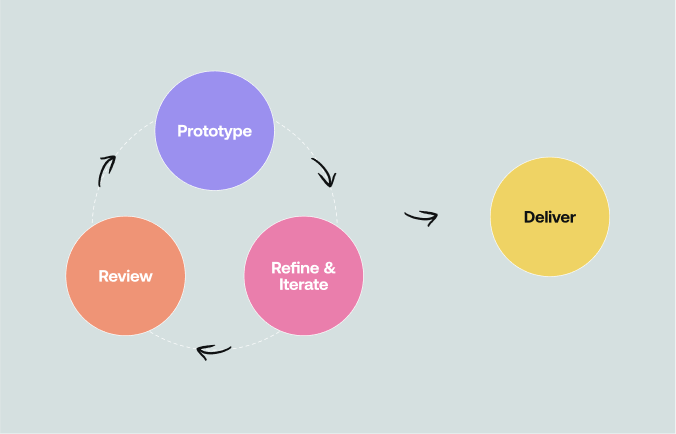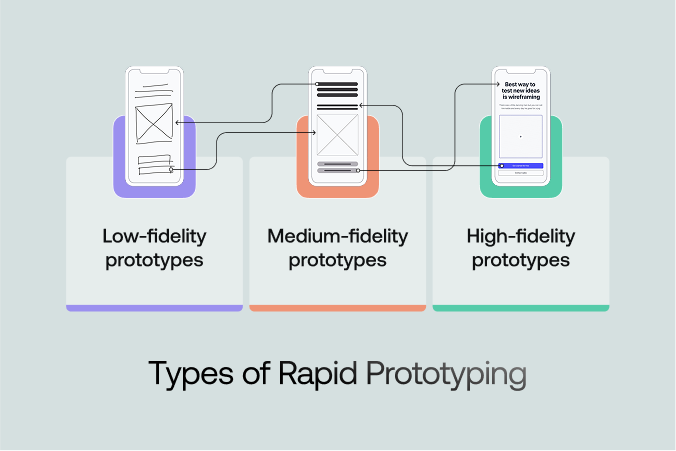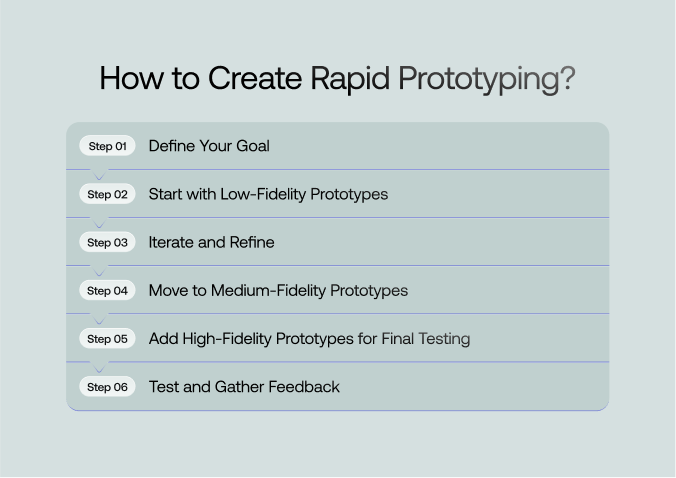
Rapid prototyping is a fast and flexible method for quickly creating models or parts. It benefits several industries, such as manufacturing, software development, and design, and helps teams visualize and test their ideas early.
Today, we will discuss what is rapid prototyping, it's types, benefits, and steps involved. If you're new to rapid prototyping or want to enhance your current process, this guide will explain how it can streamline and speed up your project development.

Rapid prototyping is a product development method used to quickly create and test a design's early versions. It involves creating prototypes that represent a product, either physically or digitally, to explore ideas and identify flaws. During this process, user feedback helps refine and improve the design. Before going on to full production, rapid prototyping helps teams develop their ideas effectively and make educated judgments.
Rapid prototyping typically includes tools like 3D modeling, simulation, and 3D printing for physical prototypes or software like Figma and Adobe XD for digital ones. The goal of rapid prototyping is to speed up the design process, reduce costs, and ensure the final product effectively meets user needs.
Prototyping is a key step in product development that helps test a product's ability to solve a specific problem. Prototypes are not always fully functional but are designed to look real enough for potential users to interact with. Businesses can easily figure out whether their ideas are effective by doing this.
The primary goal of prototyping is to identify potential flaws early, saving time and resources. If the prototype receives negative feedback, the design may not perform well in real-world conditions. Because of this, the team can alter their direction or make improvements before moving forward with development. Positive feedback indicates the design is on track, enabling progress to the next stage.
The term "rapid" in prototyping refers to how quickly the prototype is created, how fast feedback is gathered, and how swiftly improvements are made. It's a balancing act for teams; spending too much time refining a prototype can delay the process while abandoning it too soon might lead to wasted efforts and missed opportunities.
By carefully managing the pace of prototyping and feedback, teams can avoid over-investing in designs that don't work, ensuring they only move forward with fundamental potential ideas. This process of continuous iteration helps refine the product, ultimately leading to a better, more effective solution.

Rapid prototyping is a game-changer in product development. It allows designers and engineers to quickly bring their ideas to life and get real-world feedback before fully producing. Three main types of prototypes are used in rapid prototyping: High-Fidelity, Medium-Fidelity, and Low-Fidelity.
Low-fidelity prototypes are simple, rough versions of your product, often made from paper, cardboard, or basic digital sketches. They're quick to create and perfect for early-stage brainstorming. These prototypes help you figure out whether your basic ideas even work. You're not focused on looks here; it's all about testing concepts and getting a feel for the product's flow. It's a low-cost, low-risk way to identify issues before spending more time and resources on higher-fidelity designs.
Medium-fidelity prototypes strike a balance. They're less detailed than high-fidelity prototypes but still do the job. These prototypes allow you to test core aspects of your design, like how users navigate through the product or how the layout feels. They're great when you're in the middle of development and need to refine features without investing too much time or money. Think of them as a rough draft that's good enough to test key functions but not the final version.
High-fidelity prototypes are the closest thing to the final product. They look and work almost exactly like the finished version. These interactive prototypes allow users to try all the features and provide meaningful feedback. You'll typically use high-fidelity prototypes when the design is almost complete, and you want to test everything in detail before going into full production. It's all about ensuring everything works perfectly before hitting that "go" button.
Rapid prototyping is essential when quickly testing and refining ideas during product development. It's especially useful in a project's early stages when teams brainstorm and explore concepts.
Quick prototypes help identify design flaws early, allowing for improvements before investing significant time or resources. It reduces the risk of costly mistakes during later development stages.
You also need rapid prototyping when you're seeking user feedback. Prototypes allow you to present a tangible version of your product for users to interact with, even if it's not fully functional. User feedback helps determine if the design meets their needs or requires adjustments.
Rapid prototyping is important for staying ahead of competitors. It speeds up the design process, enabling you to iterate quickly and bring products to market faster. It's also helpful when working under tight deadlines or testing multiple ideas simultaneously.
Lastly, rapid prototyping is beneficial when validating a product concept before full production. If you do this, you can be confident that your concept is practical and meets user expectations. Rapid prototyping is a reliable method for making efficient and informed decisions. Teams can easily use it to test early concepts, gather feedback, or finalize designs effectively.

Creating a rapid prototype involves several key steps that allow you to turn ideas into tangible representations for testing and feedback. Here's a simple guide on how to create effective rapid prototypes:
Before beginning the prototype process, knowing what you want to test or verify is essential. Clarify your objective first, whether that means exploring design concepts, testing a feature, or validating a user experience. Defining your goal ensures the prototype remains aligned with your goal. A clear goal helps you focus on what to include in the prototype and avoids unnecessary complexity.
In the early stages of product development, low-fidelity prototypes are your best bet. These can be simple sketches, paper models, or basic digital wireframes. Low-fidelity prototypes help you test broad ideas, such as layout or basic functionality, without investing too much time. The goal at this stage is to get a rough idea of how the product might work and quickly identify glaring issues.
Once you've created your prototype, gather feedback from users or team members. Focus on the design's usability, the flow of interaction, and how well it addresses the problem you're trying to solve. Based on the feedback, make adjustments and refine your prototype. This iterative process is crucial in rapidly improving the design without wasting time or resources.
As you refine your design, it's time to move on to medium-fidelity prototypes. These are more detailed and functional than low-fidelity ones. They can include interactive elements or digital mockups that simulate the user experience more closely. At this stage, you'll want to test how well the product works and how it fits within the more extensive system. You can create these prototypes using tools like Figma, Sketch, or Adobe XD. Medium-fidelity prototypes give you a clearer sense of how the final product might feel.
Once you've reviewed the initial iterations, it's time for high-fidelity prototypes. High-fidelity prototypes are the closest to the final product in terms of both appearance and functionality. They should look polished and feel realistic. High-fidelity prototypes are often interactive and allow users to perform tasks like they would with the real product. Use this prototype to validate specific features, design choices, or interactions. This stage should highlight any final adjustments that need to be made before the product is launched.
Regardless of the prototype's fidelity, gathering feedback from real users at each stage is essential. Rapid prototyping is a testing ground; user feedback helps ensure you move in the right direction. Use their input to fine-tune the design and make informed decisions as you develop.
Rapid prototyping (RP) has transformed the design field by streamlining product development and enhancing design quality. Designers benefit from faster iteration and better validation of their concepts, which lead to more successful products. Here are some key benefits of using rapid prototyping in design:
Creating a working model of a design concept quickly is one of the core advantages of rapid prototyping. Developing and testing prototypes swiftly shortens the overall development cycle. Businesses can bring products to market much faster when design cycles are streamlined in this way.
Companies can respond swiftly to market demands, adjusting designs according to feedback without long delays. Shorter design cycles provide a competitive edge and allow businesses to lead the market with innovative solutions. As a result, rapid prototyping plays a vital role in ensuring that companies stay ahead of the competition.
Avoiding costly mistakes is crucial during the early stages of product development. Rapid prototyping helps identify design flaws before they become expensive problems. By testing prototypes early, designers can catch potential issues affecting the product's performance or aesthetics. Identifying issues early saves time and resources, as fixing problems during the prototype phase is cheaper than doing so in full-scale production.
Designers minimize rework by catching potential issues before the final product is developed. Preventing errors early reduces the likelihood of costly redesigns and prevents delays that could arise from fixing issues later in the process. In addition, designers can make informed decisions about where to continue or abandon a design before investing significant resources.
Product ergonomics is a key factor in increasing user satisfaction. Rapid prototyping allows designers to test the product's functionality, aesthetics, and ergonomic features. Prototypes also provide an opportunity to assess a product's comfort and usability. Designers can evaluate the product's fit, control locations, and surface textures to ensure the product is user-friendly.
For example, they can determine if a handle feels comfortable or if buttons are easy to reach and press. Such assessments are essential for improving the overall user experience.
Abstract concepts and sketches can only go so far in the design process. Rapid prototyping allows designers to turn ideas into tangible, working models. These functional prototypes better understand how a product looks, fits and performs. With working prototypes, designers can evaluate whether the product functions as intended, assess how it behaves in real-world scenarios, and make adjustments as necessary.
Prototypes provide hands-on experience, allowing designers to test the product's mechanics, features, and usability more accurately and effectively than drawings or 3D visualizations alone.
Rapid prototyping is an effective tool for presenting design concepts to stakeholders. Instead of relying solely on drawings or abstract ideas, prototypes provide a physical or digital representation of the design that is easier to understand. Designers can present a prototype to clients, investors, or team members to communicate their vision more clearly.
A working model helps stakeholders understand the design's impact and offer support. Feedback from these stakeholders can then be incorporated into the design process, improving the product before it reaches the market.
While rapid prototyping is mainly associated with creating test models, it also has a significant role in low-volume manufacturing. Technologies like 3D printing, injection molding, and vacuum casting can make small batches of high-quality products. These low-volume production capabilities enable companies to meet early market demand without committing to large-scale manufacturing.
Using rapid prototyping for small-scale production, businesses can test the product's market acceptance, gather customer feedback, and adjust before scaling up. This approach helps to reduce costs and risks, particularly in the case of new product launches.
Rapid prototyping encourages collaboration among team members and stakeholders. When designers, engineers, and other team members can interact with prototypes, it fosters a more open exchange of ideas. Designers can quickly get feedback from different perspectives, and adjustments can be made collaboratively.
Additionally, rapid prototyping helps streamline communication with clients, as they can physically interact with prototypes, ask questions, and suggest changes. This collaborative process leads to more refined and innovative designs.
Customer feedback is essential for product success. Rapid prototyping allows designers to share prototypes with customers early in development, gathering insights into their preferences and expectations. Customers can provide valuable input on functionality, appearance, and usability, which can be incorporated into the final design. Early customer testing ensures the product is more likely to meet market demands.
To make the most of rapid prototyping, it's important to follow some best practices that can lead to better designs and smoother workflows. Here are some best practices for effective rapid prototyping.
When designing a prototype, focus on the user. Avoid getting distracted by technical details or your vision. Think about the problems your target audience faces and design solutions for them. Test your prototype with real users early on to find any issues or areas of confusion. Use their feedback to improve the design and make it more user-friendly. This approach helps ensure your final product effectively meets their needs.
Feedback is one of the most valuable tools in the rapid prototyping process. Gather input from users, team members, and stakeholders as often as possible. Don't be afraid to show early versions of your prototype, even if it's not perfect. This feedback will give you a fresh perspective and highlight areas for improvement. The more feedback you collect, the better your design will become, so actively seek out different viewpoints throughout the process.
Prototypes are meant to be tested, but the setting where you test them matters. Test your prototype in real-world conditions to see how users will interact with it. This helps you understand how the design performs and what changes are needed.
Real-world testing often reveals issues that might not appear in a controlled setting. Testing in real environments, whether a mobile app or a physical product, gives you better feedback.
Rapid prototyping involves testing ideas quickly, so flexibility is essential. Designs should be easy to adjust and update as you get new feedback or discover better solutions. Build prototypes with the understanding that they're not set in stone. The goal is to learn and improve if you're using digital tools or physical materials. Make it easy to make changes as you go.
Involve your team throughout the prototyping process. Collaboration helps ensure that everyone's ideas and expertise are considered. Designers, developers, marketers, and other team members bring different perspectives. Their input helps you refine the prototype in ways you might not have considered.
Additionally, involving the whole team early on can prevent miscommunications and keep everyone aligned toward the same goal.
It's easy to get lost in the details of prototyping, especially when you're making frequent updates. Setting clear milestones throughout the process helps keep the project on track. These milestones should align with key objectives, such as completing a particular feature or validating a specific user experience. Clear checkpoints allow you to assess progress and adjust your course as needed.
Rapid prototyping is a key technique in product development. It lets designers and engineers quickly bring their ideas to life and improve them based on user feedback. This approach shortens the time it takes to create a product, minimizes expenses, and improves quality.
Teams can find and address any design flaws early on via rapid prototyping. The product will remain competitive and satisfy user expectations if this is done. Rapid prototyping also gives creators the confidence to innovate and deliver products that connect with their audience.
Rapid prototyping is especially useful in the automotive, healthcare, aerospace, and consumer electronics industries. It enables fast testing and tweaking of complex designs before starting mass production.
Rapid prototyping is mainly for making and testing prototypes quickly during the design phase, not for mass production. However, it can help transition from prototype to full-scale production for limited runs or to refine designs before mass production starts.
Virtual prototypes are digital models made with computer-aided design (CAD) software. They can be quickly changed and tested virtually. Physical prototypes are accurate models using techniques like 3D printing for hands-on testing and evaluation.
The time needed to develop a prototype can vary. Simple prototypes can be ready in a few days to a week, while more complex ones may take several weeks.
Rapid prototyping suits Agile development, Lean Startup, and Design Thinking. It supports repeated creation, testing, feedback, and refinement cycles, making the product development process adaptable and responsive to user needs and market shifts.


